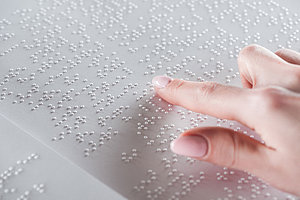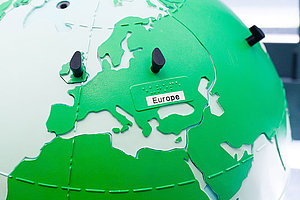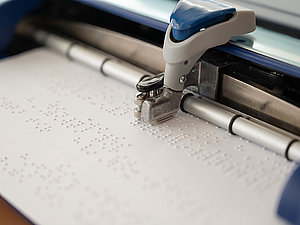How Does Braille Appear on Medical Packaging?

You can tell from reading the packaging whether your pharmacist has handed you the correct medicine as requested. Have you ever run your finger over the pattern of tiny embossed dots on the packaging?

These dots are braille and state the name of the medicine and its strength. This gives people who are blind or partially sighted the peace of mind that they have received the correct product.
As of 2006, all medical packaging in the European Union must be printed with braille so that people who are blind or partially sighted can also find what they are looking for in their medicine cabinet at home. Read on to find out how a language service provider prepares the braille lettering so that the braille embosser can stamp the correct patterns in braille onto the carton:
- The name of the medicinal product and strength must appear for each required language in braille
- The braille is proofread, taking into account variations from language to language
- The electronic file is created for the braille embosser in accordance with the DIN 32976 standard.
Once the file has been created, all the steps that a language service provider can take to transcribe a text in braille are complete. The proofs go to the printers or, specifically, to be embossed by a specialist company that uses special software and machines in order to stamp the braille onto the packaging.
1. Transcription in all required national languages: Name of the medicinal product and strength

The procedure for the first step depends on the delivered source material. Sometimes a manufacturer has already had the name of the medicine rendered in braille. In such cases, the information only needs to be proofread. The manufacturer can, however, also commission the transcription and proofreading together.
In any case, it is essential that the correct name of the product is provided for each country of distribution. As you will be aware, the names of medicinal products may vary from country to country for market launch. In order to complete the transcription and proofreading for each country with the intended name, the language service provider must be provided with all the relevant information.
After the name, the strength of the product is stated in braille. Every strength in which the medicine is available is also conveyed in braille and added after the product name. A separate template is created for each combination of name (country-specific) and strength.
2. Transcription and proofreading in accordance with the latest systems
Transcribing and proofreading the content is done in accordance with the latest braille systems for any language. What does a proofreader have to look out for?
No matter how short the line of information is, the braille system is full of complexities that the proofreader has to be familiar with. This complexity arises from the fact that braille has very few characters with which to represent all letters, numbers and characters with their own combination.
This problem is found in all languages. Because every language has its own special characteristics and, often, unique symbols, the layout space available has to be used differently from one language to the next. This means, one system for each language. Another language, another character layout.
On top of that, braille transcription recommendations are reformed from time to time. For example, France, the home of its inventor, Louis Braille, recently introduced a new method for writing numbers.

In languages using the Latin alphabet, the letters are identical. Some exceptions are the special characters (ß or ê, for instance) and punctuation specific to the individual languages. The braille system is also used in languages using other writing systems, however (such as Chinese, Hebrew and Russian).
The Spanish braille alphabet has its own symbol for ñ. In other languages, the same character takes on another meaning. The frequency of letters featuring accents (à, â, é, è, î, ï, ô, û) as used by the specific language is also taken into account through the limited number of combinations available.
In German braille, we distinguish between Basisschrift, Vollschrift and Kurzschrift forms. The DIN EN ISO 17351 standard is applied for the use of braille on pharmaceutical packaging.
Basisschrift, Vollschrift and Kurzschrift forms in German. Braille is available in various forms.
In the Basisschrift form, each letter is transcribed individually.
In the Vollschrift form, some groups of letters are shortened as a single character. In German, these groups of letters are ie, ei, eu, äu, au, ch, sch and st.
In the Kurzschrift form, groups of letters, root words and prefixes and suffixes are represented with one or two characters that have different meanings depending on where they are placed in the word.
Once all the names under which the product is to be marketed have been transcribed and proofread in the national languages, the lettering can be saved electronically.
3. Creating the embossing template in accordance with DIN 32976
Braille software supports the correct usage of the language, from the transcription to the preparation of the optical template. The software converts .doc and .html files into a special file format for braille that can be read by printers and braille embossers.

But it is even more commonplace to create a .pdf file rather than using the .brl file format. The PDF is more practical because it is an everyday format that is more widely used. The lettering is inserted in its own layer and a suitable graphics program can ensure that the lettering in the print file fully complies with the DIN standard.
The DIN standard determines, for example, the point size, height and spacing, as well as its position on the packaging. According to the standard, the braille may not cover the bar code and must be saved in the document with its own color. The finished embossing should ideally stand out 0.2 mm.
If it is flatter than this, the braille is harder to read. If it is higher than this, the overprint is harder to read. If the machine embosses too heavily, the surface of the packaging material may be damaged. The norm ensures the ideal accessibility for both groups of patients.
The final result is an optical braille template:
- A .brl or .pdf file
- With the name of the medicinal product and all available strengths in braille
- Transcribed into all target languages and proofread
- Aligned with the DIN standard
- Can be read directly by the printer or braille embossing machine
mt-g is specialized in the EU. The irresistible simplicity and efficiency of the character system has taken braille far beyond the borders of Europe. With its 64 characters, braille can be used even for languages not written in the Latin alphabet with an incredible number of characters of their own. The last fold-out box explains how this is done.
Braille in non-Latin alphabets
Cyrillic and pictographic languages such as Chinese and Korean use the combinations in a completely different way. Only very few letters, such as e, p and t, are the same in Cyrillic. There is no q and so the braille symbol for that is used for the sound tsch instead. Pictographic languages require a completely different system, which is why the combinations of dots in Chinese represent the most common sounds. As a result, the braille version of Chinese represents its sounds instead.
Do you have specialist braille projects that require individual solutions? Ask us about it; we’ll get to grips with it.


